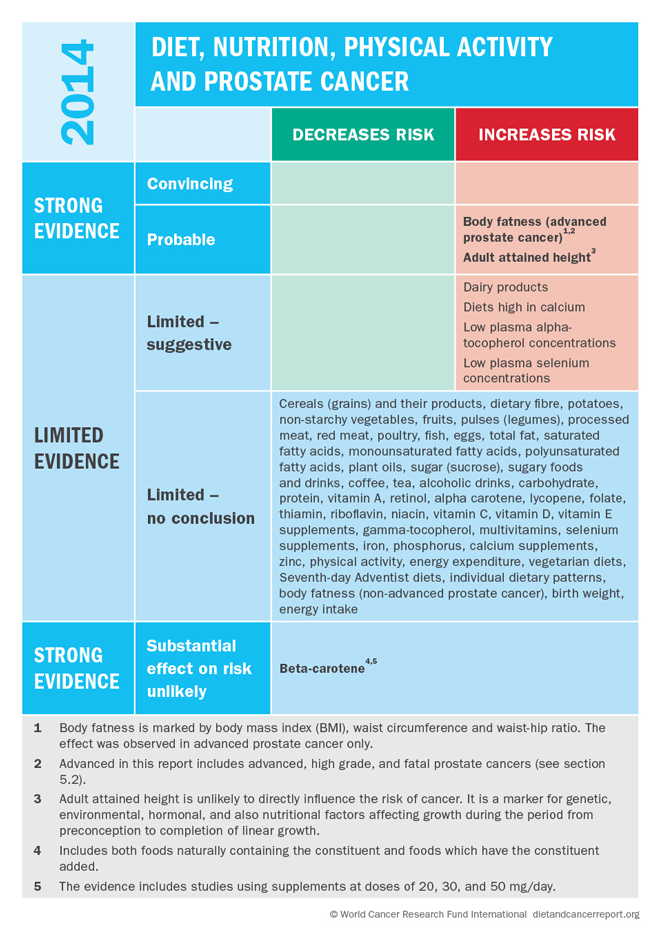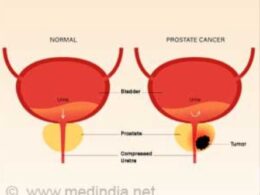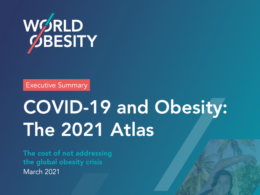In total, this report analyses 104 studies from around the world, comprising over 9 million men and 191,000 cases of prostate cancer.
World Cancer Research Fund International
2018
What is prostate cancer?
The prostate is a walnut sized gland in men that surrounds the top of the urethra just below the bladder outlet; it produces seminal fluid. Male hormones, such as testosterone, control its growth and function.
Incidence and survival rates
Prostate cancer is the second most common cancer worldwide, and the fifth most common cause of cancer death among men.
Almost all cases are adenocarcinoma, a glandular malignancy.
- Around 1.1 million new cases were recorded worldwide in 2012,
- accounting for 15 per cent of all new cases of cancer in men.
Prostate cancer is more common as men age, in the US 97 per cent of all prostate cancers are diagnosed in men 50 years or older.
Incidence rates of prostate cancer vary by more than 25-fold in different parts of the world;
- the highest rates are in Australia and New Zealand, Northern and Western Europe and North America.
A proportion of the variation in incidence rates can be explained by differences in screening practices, notably screening for prostate-specific antigen (PSA).
Early prostate cancer detected by screening usually has no symptoms.
- With more advanced disease men may experience weak or interrupted urine flow;
- the inability to urinate or difficulty starting or stopping urine flow;
- the need to urinate frequently, especially at night;
- blood in the urine;
- or pain or burning with urination, but these symptoms may also be due to a common condition called benign prostatic hyperplasia.
Prostate cancer that has spread often presents as bone pain. The five- and ten-year survival is high in Europe and North America, but lower in some Asian and African countries.
Lifestyle factors and prostate cancer risk
In this report from our Continuous Update Project (CUP) — the world’s largest source of scientific research on cancer prevention and survivorship through diet, nutrition and physical activity — we analyse global research on how certain lifestyle factors affect the risk of developing prostate cancer.
This webpage forms part of the World Cancer Research Fund/American Institute for Cancer Research Third Expert Report Diet, Nutrition, Physical Activity and Cancer: a Global Perspective.

Findings on prostate cancer
There is strong evidence that:
- being overweight or obese INCREASES the risk of advanced prostate cancer
- being tall INCREASES the risk of prostate cancer
- consuming beta-carotene (in the diet or as supplements) is unlikely to have a substantial effect on the risk of prostate cancer
There is some evidence that:
- higher consumption of dairy products might increase the risk of prostate cancer
- diets high in calcium might increase the risk of prostate cancer
- low plasma alpha-tocopherol concentration (vitamin E) might increase the risk of prostate cancer
- low plasma (blood) selenium concentrations might increase risk of prostate cancer

Other causes of prostate cancer
There are no other established causes of prostate cancer.
Pathogenesis
The disease usually develops slowly and dysplastic lesions may precede cancer by many years or even decades.
The prevalence of latent prostate cancer at autopsy is high and increases with age. Overt and clinically relevant disease is less common.
The introduction of PSA screening has contributed to the detection of cancer at an earlier stage.
Although this likely contributes to a reduction in mortality, because a significant number of indolent lesions that might never progress to become clinically overt are also detected, many of which are treated, it also leads to the phenomenon of over treatment.
Adenocarcinoma of the prostate is thought to arise primarily from an in situ proliferation of neoplastic prostatic epithelial cells. Metastasis of prostatic adenocarcinoma is mainly to the lymph nodes and to bone.
Non-modifiable risk factors are age, race and familial history. Elevated blood concentrations of insulin-like growth factor (IGF)-1 have been implicated as a potentially modifiable risk factor. Other modifiable risk factors have been suggested but the evidence has been inconsistent.
Genetic susceptibility has been linked to African heritage and familial disease. In the US, African American men are 1.6 times more likely to develop prostate cancer than Caucasian men. A large number of single-nucleotide polymorphisms that modestly affect risk have also been identified.
How the research was conducted
The global scientific research on diet, nutrition, physical activity and the risk of prostate cancer was systematically gathered and analysed, and then independently assessed by a panel of leading international scientists in order to draw conclusions about which of these factors increase or decrease the risk of developing prostate cancer.
Published findings in peer-reviewed journals
Selected findings from this report have been published in peer-reviewed journals. Details of the papers and links to the abstract in PubMed are below:
Selenium and prostate cancer: systematic review and meta-analysis. Hurst R, Hooper L, Norat T, Lau R, Aune D, Greenwood DC, Vieira R, Collings R, Harvey LJ, Sterne JA, Beynon R, Savovic J & Fairweather-Tait SJ. Am J Clin Nutr. 2012; 96(1): 111–22. Abstract
Dairy products, calcium, and prostate cancer risk: A systematic review and meta-analysis of cohort studies. Aune D, Navarro Rosenblatt DA, Chan DSM, Vieira AR, Vieira R, Greenwood DC, Vatten LJ & Norat T. Am J Clin Nutr 2014; 101(1): 87–117. Abstract
The cancer statistics quoted in the Third Expert Report are from the GLOBOCAN 2012 database. The International Agency for Research on Cancer (IARC) updated these statistics in September 2018, after the publication of the Third Expert Report. Find the latest prostate cancer statistics.
Originally published at https://www.wcrf.org.












